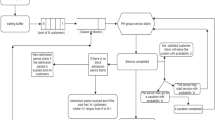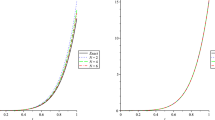Abstract
Queueing systems with several servers and a special discipline whereby demands are successively received by servers until the servicing is completed are considered. Among these systems, there are such systems whose characteristics constantly depend on a certain positive parameter. Given integer values of the latter, the waiting probability and average sojourn time coincide with those calculated using the Erlang C formula. Therefore, these systems can be considered as generalizations of the classical M/M/s system to a fractional number of servers.
Similar content being viewed by others
References
Erlang, A.K., Løsning af nogle problemer fra sandsynlighedsregningen af betydning for de automatiske telefoncentraler, Elektroteknikeren, 1917, vol. 13, pp. 5–13.
Stasiak, M., et al., Modeling and Dimensioning of Mobile Wireless Networks: From GSM to LTE, Chichester: Wiley, 2011.
Basharin, G.P., Kokotushkin, V.A., and Naumov, V.A., Method of equivalent substitutions in theory of teletraffic, Itogi Nauki Tekhn. Elektrosvyaz, 1980, vol. 2, pp. 82–122.
Nightingale, D.T., Computations with smooth traffics and Wormald chart, Proc. 8th Int. Teletraffic Congress, Sydney, 1976.
Naumov, V. and Martikainen, O., Method for Throughput Maximization of Multiclass Network with Flexible Servers, Helsinki: The Research Institute of the Finnish Economy, 2011, p. 1261.
Bretschneider, G., Extension of the equivalent random method to smooth traffics, extension of the equivalent random method to smooth traffics, Proc. 7th Int. Teletraffic Congress, Stockholm, 1973.
Jagers, A.A. and van Doorn, E.A., Convexity of functions which are generalizations of the Erlang loss function and the Erlang delay function, SIAM Rev., 1991, vol. 33, no. 2, pp. 281–282.
Iversen, V.B., Teletraffic Engineering Handbook. Geneva: ITU. 2001. http://www.itu.int/ITU-D/study-groups/SGP-1998-2002/SG2/StudyQuestions/Question-16/RapporteursGroupDocs/teletraffic.pdf (accessed 14.04.2013).
Jagerman, D.L., Some properties of the Erlang loss function, Bell System Techn. J., 1974, vol. 53, pp. 525–551.
Martinez, W.L. and Martinez, A.R., Computational Statistics Handbook with MATLAB, New York: Chapman and Hall, 2002.
Gnedenko, B.V and Kovalenko, I.N., Vvedenie v teoriyu massovogo obsluzhivaniya (Introduction into Mass Service Theory), 6th Ed., Moscow: LKI, 2013.
Lazowska, E.D., Zahorjan, J., Graham, G.S., and Sevcik, K.C., Quantitative System Performance Computer System Analysis Using Queuing Network Models, London: Prentice-Hall, 1984.
Author information
Authors and Affiliations
Corresponding author
Additional information
Original Russian Text © V.A. Naumov, O.E. Martikainen, 2013, published in Avtomatika i Vychislitel’naya Tekhnika, 2013, No. 4, pp. 76–84.
About this article
Cite this article
Naumov, V.A., Martikainen, O.E. On queueing systems with a fractional number of devices. Aut. Control Comp. Sci. 47, 219–225 (2013). https://doi.org/10.3103/S0146411613040056
Published:
Issue Date:
DOI: https://doi.org/10.3103/S0146411613040056




